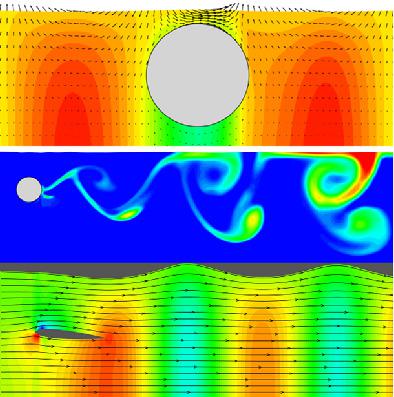当前位置:
X-MOL 学术
›
Int. J. Numer. Methods Fluids
›
论文详情
Our official English website, www.x-mol.net, welcomes your
feedback! (Note: you will need to create a separate account there.)
Nonhydrostatic model for free surface flow interaction with structures
International Journal for Numerical Methods in Fluids ( IF 1.7 ) Pub Date : 2021-03-31 , DOI: 10.1002/fld.4985 Scott F. Bradford 1
International Journal for Numerical Methods in Fluids ( IF 1.7 ) Pub Date : 2021-03-31 , DOI: 10.1002/fld.4985 Scott F. Bradford 1
Affiliation

|
Simulating fluid–structure interactions is important in many engineering applications. Navier–Stokes based models can accurately simulate free surface flows and efficiency is improved by transforming the equations into the sigma-coordinate system in which the grid follows the free surface and bottom. This approach lacks the ability to simulate wave overturning and splashing, but it has been demonstrated to accurately simulate breaking waves. Incorporating structures in a free surface flow model is challenging. Many existing techniques require complex grids and cumbersome interpolation. The immersed boundary method avoids complicated grids by overlaying the object on the grid. Interpolation is still required at the object boundary, which may not conserve mass. It is also difficult to compute the force acting on the body. Conservation may be reclaimed by embedding the object into the mesh. However, this may result in small (cut) cells and numerical instability unless they are merged with neighboring cells. In this article, a new model is proposed and constructed using a modified sigma coordinate transformation. This limits the model to simulating objects that can be represented by upper and lower surfaces that are functions of x and y, but still allows for many simulations of engineering interest. In exchange for this compromise, several advantages are gained including: efficiency, mass conservation, and easy estimation of force. Model accuracy is demonstrated by comparing numerical predictions with analytical solutions and laboratory measurements for free surface flows interacting with a horizontal cylinder and NACA 0012 foil.
中文翻译:

自由表面流动与结构相互作用的非流体静力模型
模拟流固耦合在许多工程应用中都很重要。基于 Navier-Stokes 的模型可以准确地模拟自由表面流动,并且通过将方程转换为网格跟随自由表面和底部的 sigma 坐标系来提高效率。这种方法缺乏模拟波浪翻转和飞溅的能力,但已被证明可以准确模拟破碎的波浪。在自由表面流动模型中结合结构具有挑战性。许多现有技术需要复杂的网格和繁琐的插值。浸入边界法通过将对象叠加在网格上来避免复杂的网格。在物体边界处仍然需要插值,这可能不守恒质量。计算作用在身体上的力也很困难。可以通过将对象嵌入到网格中来回收守恒。但是,这可能会导致小(切割)单元格和数值不稳定,除非它们与相邻单元格合并。在本文中,提出并使用改进的 sigma 坐标变换构建了一个新模型。这将模型限制为模拟可以由作为 x 和 y 的函数的上表面和下表面表示的对象,但仍然允许进行许多具有工程意义的模拟。作为这种折衷的交换,获得了几个优点,包括:效率、质量守恒和易于估计力。通过将数值预测与解析解和实验室测量值进行比较,对与水平圆柱体和 NACA 0012 箔相互作用的自由表面流进行比较,证明了模型的准确性。
更新日期:2021-03-31
中文翻译:

自由表面流动与结构相互作用的非流体静力模型
模拟流固耦合在许多工程应用中都很重要。基于 Navier-Stokes 的模型可以准确地模拟自由表面流动,并且通过将方程转换为网格跟随自由表面和底部的 sigma 坐标系来提高效率。这种方法缺乏模拟波浪翻转和飞溅的能力,但已被证明可以准确模拟破碎的波浪。在自由表面流动模型中结合结构具有挑战性。许多现有技术需要复杂的网格和繁琐的插值。浸入边界法通过将对象叠加在网格上来避免复杂的网格。在物体边界处仍然需要插值,这可能不守恒质量。计算作用在身体上的力也很困难。可以通过将对象嵌入到网格中来回收守恒。但是,这可能会导致小(切割)单元格和数值不稳定,除非它们与相邻单元格合并。在本文中,提出并使用改进的 sigma 坐标变换构建了一个新模型。这将模型限制为模拟可以由作为 x 和 y 的函数的上表面和下表面表示的对象,但仍然允许进行许多具有工程意义的模拟。作为这种折衷的交换,获得了几个优点,包括:效率、质量守恒和易于估计力。通过将数值预测与解析解和实验室测量值进行比较,对与水平圆柱体和 NACA 0012 箔相互作用的自由表面流进行比较,证明了模型的准确性。











































 京公网安备 11010802027423号
京公网安备 11010802027423号